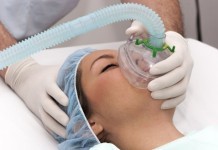Examining one lung is hard enough, but two of them??!! TWO??!! UGHHHHH!! This is so much work! If you only have the stamina to examine one lung, definitely choose wisely. Or if you have a friend, tag team; each take one lung.
 Initial Survey
Initial Survey
Assess the patient’s level of distress. Is the respiratory rate 16, the documented respiratory rate of every patient ever no matter what? Or is it 16? A rate of 16 can be reassuring, but a rate of 16 can be highly worrisome. Pay attention to other important clues: did the patient self-extubate, or, worse, self-intubate?
Teaching point: Self-intubation is a telltale sign of a patient in distress. Pursed lip, cursed lip, thirst lip, and liverwurst lip breathing are always concerning so take these very seriously. You never want to miss the tripod position in a patient with COPD. But don’t overlook the less common dipod and tetrapod positions either.
Inspection
Look at the shape of the chest and its movement, then ask yourself why you’re doing this. Instead, take inspection to another level: perform a bedside thoracotomy and take a looksie. Healthy lungs look like pink airbags.
Palpation
Chest expansion is best tested with two examiners. The first examiner should place his or her thumbs posteriorly around the patient’s tenth ribs, fingers pointing outward. Next, the second examiner should blow into the patient’s mouth as hard as possible (have the patient pinch his or her nose closed). Watch the distance between your thumbs move apart. Watch the eyeballs pop out of your patient’s head. To test for tactile fremitus, place the ulnar surface of your hands on the patient’s back and have him or her repeat the phrase “tactile fremitus” over and over again.
Percussion
This challenging but critically-important skill is difficult to master, but over time you should be able to play Mozart’s Requiem with pleasure and ease using only the patient’s lung fields and your fingers. Always remember: normal lungs are resonant, hyperinflated lungs are hyperresonant, and Mozart’s Requiem is magnificent.
External Auscultation
Have the patient breathe deeply with his or her mouth. Then using a really shitty, low-quality, disposable stethoscope, fail to hear anything. Listen for any added (adventitious) sounds, such as snaps, crackles, and pops. Have the patient say “99.” It’s called bronchophony if the “99” sounds like “Wayne Gretzky.” Have the patient say “E.” It’s called egophony if the E sounds like an A. If it sounds like a B, C, D, or any other letter of alphabet, I’m not sure what that’s called. Finally, have the patient whisper “99.” Whispered pectoriloquy is a maneuver used in drama whereby a patient conveys his or her thoughts to the audience by talking out loud while other patients remain oblivious. Shakespeare’s pectoriloquys are some of the most famous ones ever auscultated.
Internal Auscultation
Have the patient take another deep breath and aspirate the end of your stethoscope. With precision and pizazz, internally auscultate as many individual alveoli as possible.
Other Maneuvers
Submerge the patient in a tank of water and have the patient hold his or her breath as long as possible without drowning. Normal result: not drowning. Finally, with the patient in a supine position, slide the patient into a CT scanner and rule out PE.
More Physical Exam Tips below:
– The Heart
– The Abdomen
– The Eye
– The Nervous System







